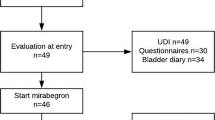Abstract
Introduction and hypothesis
The aim of this study was to assess whether urethral dilatation (UD) leads to changes in pressure flow parameters in women with voiding dysfunction (VD) and whether this correlates with improvement in overactive bladder symptoms (OAB).
Methods
Forty three women with drug-resistant OAB and VD underwent cystoscopy and UD. Pressure flow studies were undertaken at 6 weeks with further follow-up at 6 months. Any significant changes in pressure flow parameters after UD were evaluated.
Results
Thirty three percent of the participants reported subjective improvement. This was maintained at 6 months in 19%. Improvement in OAB was associated with an increase in maximum flow rate centile (p = 0.02) and a decrease in detrusor pressure at maximum flow (p = 0.03). Thirteen percent developed urodynamic stress incontinence.
Conclusions
Thirty three percent of women with drug-resistant OAB have a short-term improvement following UD. Improvement is associated with an increased maximum flow rate centile and a decreased detrusor pressure at maximum flow. The long-term improvement rate is poor.
Similar content being viewed by others
References
Dwyer P, Desmedt E (1994) Impaired bladder emptying in women. Aust N Z J Obstet Gynaecol 34:73–78
Irwin D, Milsom I, Hunskaar S et al (2006) Population based survey of urinary incontinence, overactive bladder, and other lower urinary tract symptoms in five countries: results of the EPIC study. Eur Urol 50:1306–1314
Haylen B, Krishnan S, Schulz S et al (2007) Has the true prevalence of voiding difficulty in urogynaecology patients been underestimated? Int Urogynecol J Pelvic Floor Dysfunc 18:53–56
Groutz A, Blaivas J (2002) Non-neurogenic female voiding dysfunction. Curr Opin Urol 12:311–316
Lemack G, Foster B, Zimmern P (1999) Urethral dilatation in women: a questionnaire based analysis of practice patterns. Urology 54:37–43
Kelleher C, Cardozo L, Khullar V, Salvatore S (1997) A new questionnaire to assess the quality of life of urinary incontinent women. Br J Obstet Gynaecol 104:1374–1379
Dietz HP, Haylen B (2005) Symptoms of voiding dysfunction: what do they really mean? Int Urogynecol J Pelvic Floor Dysfunc 16:52–55
Groutz A, Blaivas J, Chaikin D (2000) Bladder outlet obstruction in women: definition and characteristics. Neurourol Urodyn 19:213–220
Carson C, Segura J, Osborne D (1980) Evaluation and treatment of the female urethral syndrome. J Urol 124:609–610
Rutherford A, Hinshaw K, Essenhigh D, Neal D (1988) Urethral dilatation compared with cystoscopy alone in the treatment of women with recurrent frequency and dysuria. Br J Urol 61:500–504
Santucci R, Payne C, Saigal C, Urologic Diseases in America Project (2008) Office dilation of the female urethra: a quality of care problem in the field of urology. J Urol 180:2068–2075
Thomas AW, Abrams P (2000) Lower urinary tract symptoms, benign prostatic obstruction and the overactive bladder. BJU Int 85(Suppl 3):57–68
Duckett J, Basu M (2007) The predictive value of pre-operative pressure flow studies in the resolution of detrusor overactivity and overactive bladder after tension-free vaginal tape insertion. BJU Int 99:1439–1442
Kayigil O, Metin A, Atmaca A (2007) Obstructive urodynamic findings in idiopathic detrusor overactivity. Int Urol Nephrol 39:445–448
Karram M, Partoll L, Bilotta B, Angel O (1997) Factors affecting detrusor contraction strength during voiding in women. Obstet Gynecol 90:723–726
Sze E, Miklos J, Karram M (1996) Voiding after Burch colposuspension and effects of concomitant pelvic surgery: correlation with pre-operative voiding mechanism. Obstet Gynecol 88:564–567
Stanton S, Ozsoy C, Hilton P (1983) Voiding difficulties in the female: prevalence, clinical and urodynamic review. Obstet Gynecol 61:144–147
Chassagne S, Bernier P, Haab F, Roehrborn C, Reisch J, Zimmern P (1998) Proposed cut-off values to define bladder outlet obstruction in women. Urology 51:408–411
Balivas J, Groutz A (2000) Bladder outlet obstruction nomogram for women with lower urinary tract symptomatology. Neurourol Urodyn 19:553–560
Uehling D (1978) The normal caliber of the female urethra. J Urol 120:176–177
Robinson D, Anders K, Cardozo L, Bidmead J, Dixon A, Balmforth J, Rufford J (2003) What do women want? Interpretation of the concept of cure. J Pelvic Med Surg 9:273–277
Conflicts of interest
None.
Author information
Authors and Affiliations
Corresponding author
Rights and permissions
About this article
Cite this article
Basu, M., Duckett, J. The effect of urethral dilatation on pressure flow studies in women with voiding dysfunction and overactive bladder. Int Urogynecol J 20, 1073–1077 (2009). https://doi.org/10.1007/s00192-009-0904-z
Received:
Accepted:
Published:
Issue Date:
DOI: https://doi.org/10.1007/s00192-009-0904-z




